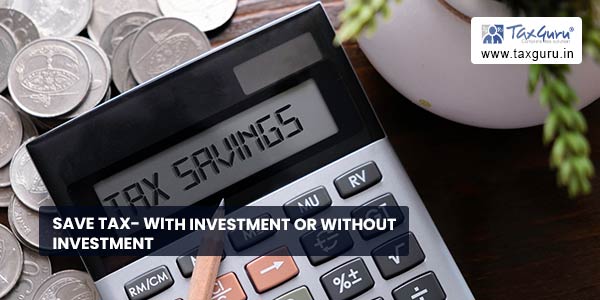The March ending of a financial year is not just important for CA’s in completing the income tax assignments for the previous financial year but also for taxpayers in order to invest in different instruments for tax saving purposes. However the perception has changed in recent times and now the taxpayers not only want to save tax but also desire of such investment products which can cater to their long term investment planning. The Chapter VI-A of the IT Act lays down various schemes to help the taxpayers to save the tax. However this article brings out only some of the notable and most common means of saving the tax among the individual and HUF categories of taxpayers. The tax saving instruments have been so perfectly made for the taxpayers that in certain cases you don’t even need to invest any additional amount to save the tax. At first the article will explain certain most simple means of saving the tax by way of additional investment followed with tax minimisation without any additional investment. The tax deduction in section 80C is however limited to the extent of Rs.1,50,000. Similarly every other section which serve the purpose of tax saving has a maximum limit for the quantum of deduction allowed to the taxpayers.
The first and the most common route for taxpayers to save tax are through investment in LIC u/s 80C. The life insurance premium paid or deposited in the previous year by the assesse is completely allowed as deduction from the gross total income. The best part of the investment in LIC is that the deduction is not only allowed for premium paid on insurance of self but also for spouse and any child in case of an individual and any member in case of HUF. Along with LIC, deduction is also provided under section 80D for the payment of medical insurance premium of assessee or his family (which means spouse and dependent children) or the parents of the assessee. Similar to LIC, another such kind of instrument which gives tax benefit for self; spouse and any child in case of individual and any member in case of HUF, is contribution to Provident Fund Scheme. The contribution to Provident Fund scheme is a three tier way of saving the tax where not only investment helps in reducing the tax, but the interest earned from the scheme and the maturity amount received is also exempt u/s 10 of the Income Tax Act.

Another most common investment for tax saving purpose along with a dual objective of long term investment need is subscription to National Saving Scheme Certificate (NSC). The investment in NSC not only provides the taxpayer to deduct the investment made from the Gross Total Income but also interest earned in NSC in case of re-investment is allowed as a deduction u/s 80C. The government also provides facility to the taxpayers to enter into financial markets with an additional benefit of saving the tax by providing deduction u/s 80C for subscription to any units of Mutual Funds referred u/s 10(23D) i.e Equity Linked Saving Scheme. The government has So Folks! Mutual Funds actually mei Sai Hai. The government has also taken a remarkable step on the slogan of “Beti Bachao Beti Padao” by providing facility to the taxpayer for deduction of sum deposited in Sukanya Samridhi Account in the name of the individual or any girl child of the individual.
Now as earlier said there are certain other means also for saving the tax without any additional investment. The section 80C of the Act provides deduction for payment of tuition fees to any university, college, school or any other educational institution situated within India for the purpose of full time education of any two children of individual. In one of such other means of saving tax without any additional investment, the taxpayer can avail full deduction of principal repayment of loan taken for cost of purchase or construction of a residential house property and also the stamp duty, registration fees and other expenses for transfer of such house property to the assessee.
The taxpayer can also claim benefit for the purposes of tax saving through rental income paid. The rental expenses incurred by a salaried employee are already covered under HRA exemption u/s 10 of the IT Act. However according to Section 80GG any individual whether self-employed or in employment can also claim deduction of expenditure incurred in respect of furnished or unfurnished accommodation occupied by such individual for the purpose of his/her own residence, provided he is not receiving HRA or not provided with any rent free accommodation and subject to such prescribed conditions and limitations as provided in IT Act.
The Government of India has introduced one more important section in the form of Section 80JJAA where deduction is allowed to employer in respect of new employees and without any single additional investment. Any assessee having income from business and liable for tax audit under section 44AB will be allowed deduction of 30 percent of additional employee cost incurred during the previous year in the course of business, for three assessment years including the year in which such employment was provided, subject to such conditions and limitations as provided in the IT Act. The government has introduced newer tax regime under section 115BAC which provides for lower rate of tax rate subject to the conditions that the total income is computed without any tax exemptions or deductions. However section 80JJAA deduction can be claimed even when the taxpayer has opted for newer tax regime.
Thus it can be seen how the government of India has provided various facilities to the taxpayers for minimization of tax liability by doing certain investment, which also serve as a tool for long term investment planning or without any additional investment provided the taxpayer is fully aware of its rights. Hence it is important to complete your tax planning before 31st March.





